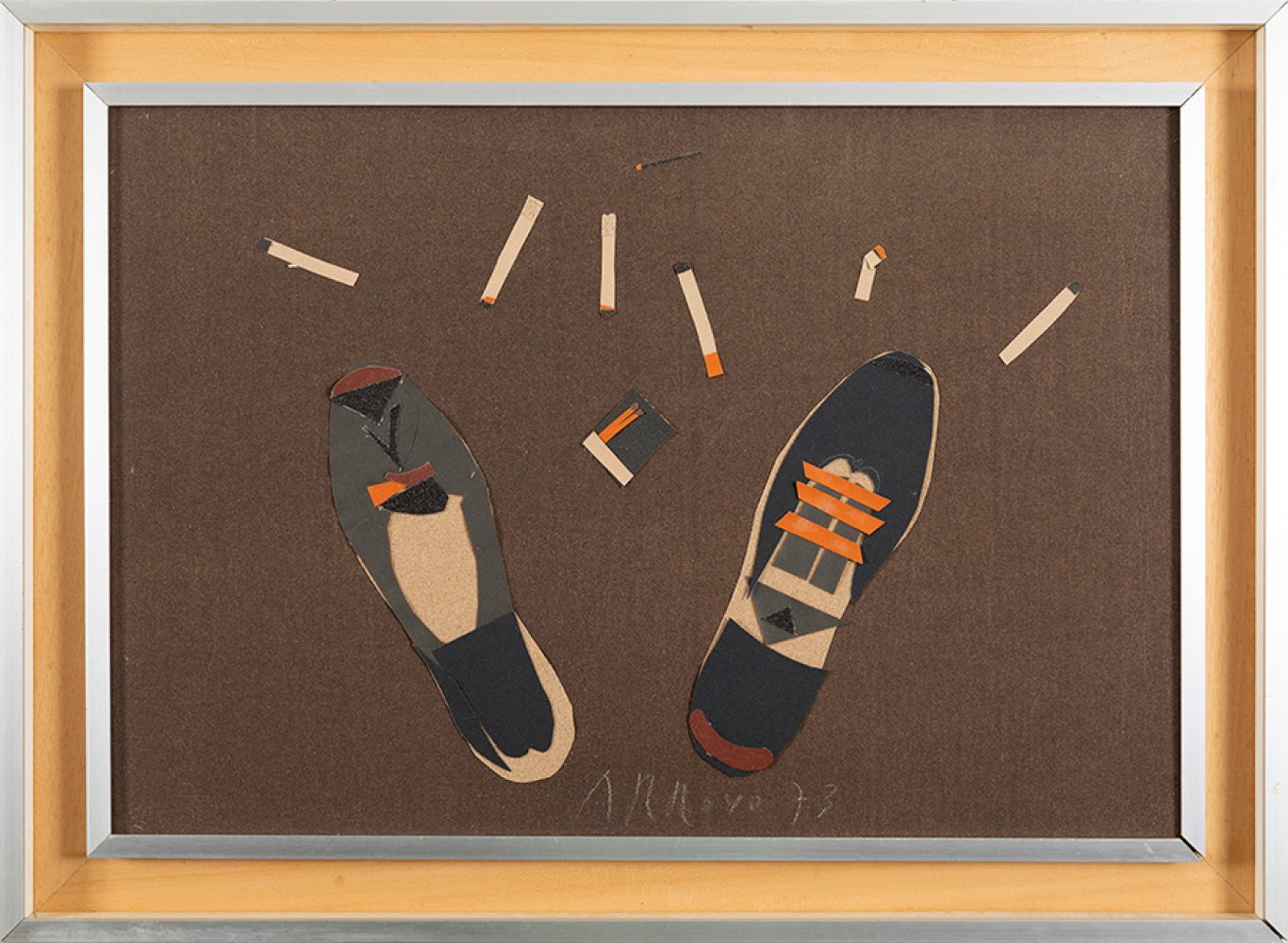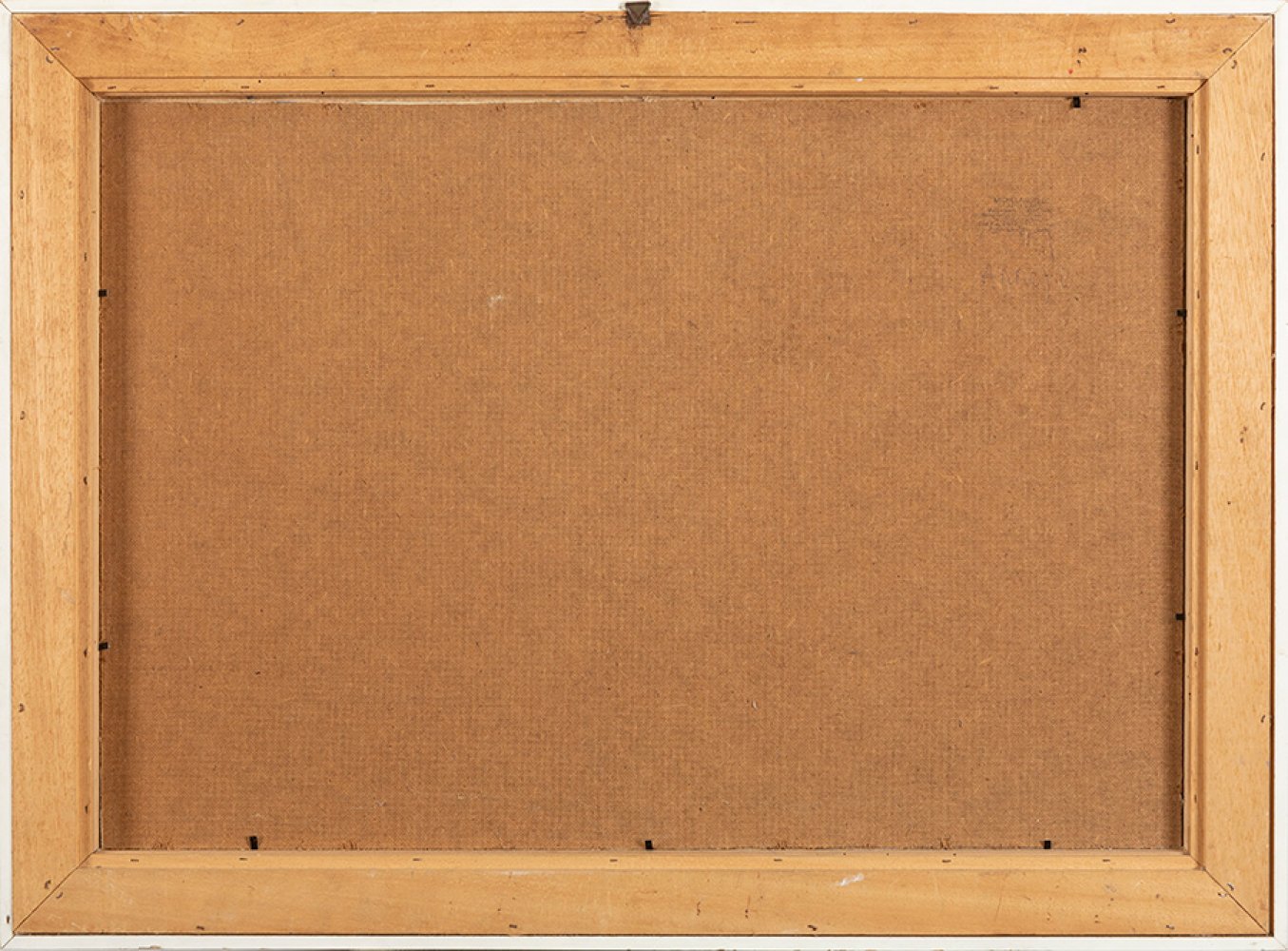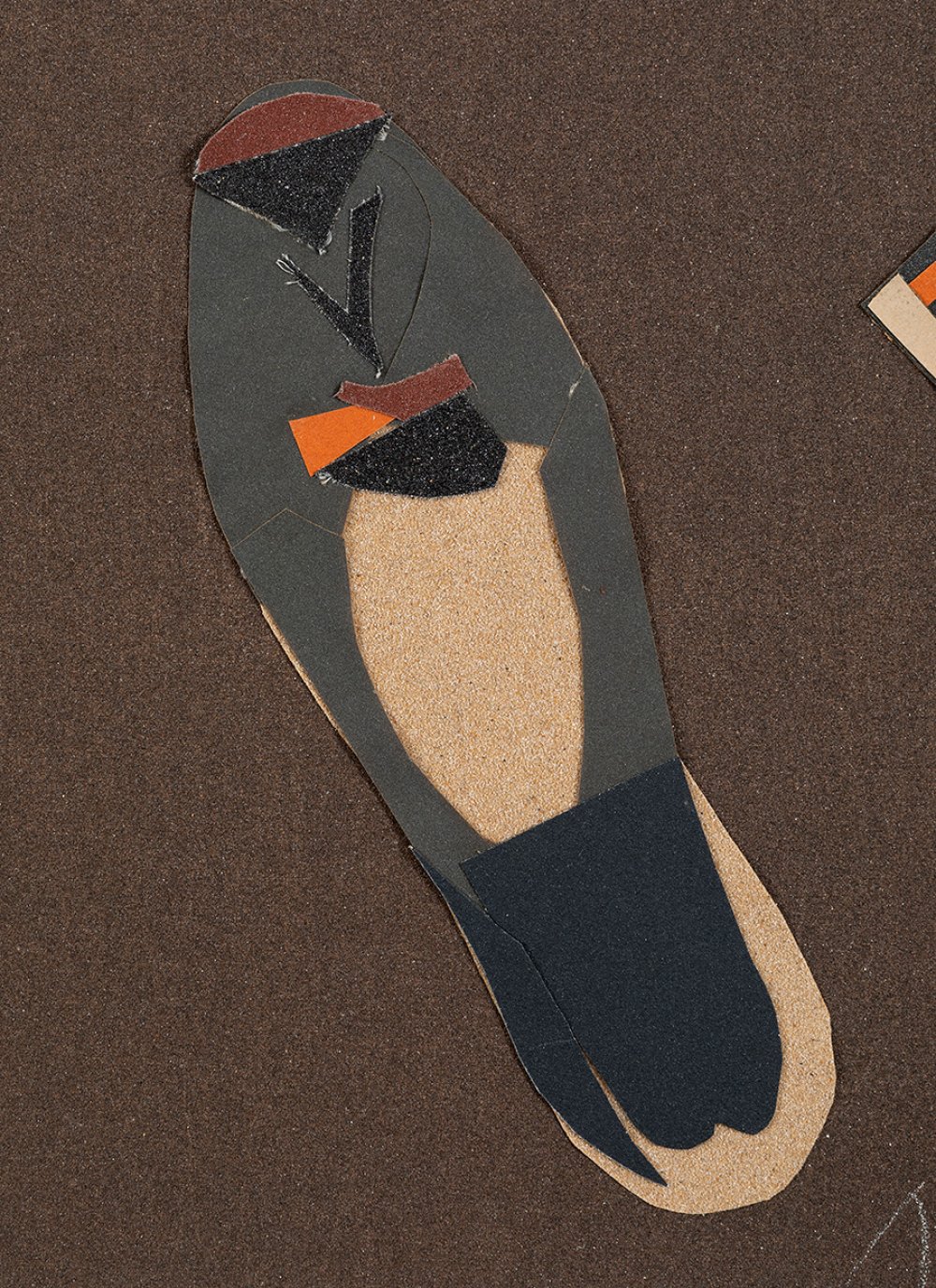35
EDUARDO ARROYO (Madrid, 1937-2018)."Untitled".1973.Collage on paper adhered to board.Signed and
"Untitled".1973.
Collage on paper adhered to board.
Signed and dated in the lower area.
Size: 47,8 x 68,5 cm; 60 x 81 cm (frame).
In this collage, the shoes and matches could make some veiled reference to exile, a theme Arroyo dealt with in the 1970s, often linking it to footprints and the loss of footwear.
A painter, sculptor and engraver, Arroyo stands out as an important figure in the neo-figurativist movement. A key figure in the new Spanish figuration, Arroyo came to prominence on the national art circuit only belatedly, from the 1980s onwards, after a two-decade period of withdrawal forced by the Franco regime. Today, his works hang in the most reputed Spanish museums and his creativity extends to theatrical scenographies and illustrated editions. Arroyo began his career in journalism, finishing his studies in 1957. He then left for Paris, fleeing the stifling Spanish political climate of the time. Although his first vocation was as a writer, a task he continues to pursue to this day, by 1960 he was already making a living as a painter. That year he took part for the first time in the Salon de Peinture Jeunesse in Paris. His critical attitude towards dictatorships, both political and artistic, led him to take controversial initiatives. He opted for figurative painting at a time when abstract painting was overwhelmingly dominant in Paris, and his early themes were reminiscent of "black Spain" (effigies of Philip II, bullfighters, dancers), worked in a caustic and unromantic manner. At the beginning of the 1960s his plastic vocabulary moved under the American influence of pop art, and in 1964 his break with informal art became definitive. His first public impact came in 1963, when he presented a series of effigies of dictators at the Third Paris Biennial, which provoked protests from the Spanish government. That same year, Arroyo prepared an exhibition at the Biosca gallery in Madrid, which opened without his presence as he had to flee to France, pursued by the police; the exhibition was censored and closed a few days later. However, Arroyo's figurative option was slow to be accepted in Paris. The painter rejected the unconditional devotion to certain avant-gardists, such as Duchamp or Miró, which he considered to be imposed by fashions. His real interest was in demystifying the great masters and defending the role of the market as a protector and thermometer of art, as opposed to the network of museums and influences paid for with public money. In 1974, Arroyo was expelled from Spain by the regime, and would not recover his passport until Franco's death. However, his critical breakthrough in Spain was not immediate, and was delayed until the early 1980s. In 1982 he was awarded the Premio Nacional de Artes Plásticas, and anthological exhibitions were held at the Biblioteca Nacional in Madrid and the Centre Pompidou in Paris. Arroyo is currently represented at the Museo Nacional Reina Sofía in Madrid, the Patio Herreriano in Valladolid, the Museo de Bellas Artes in Bilbao, the Hirshhorn Museum and Sculpture Garden in Washington D.C. and the Museo de Arte Moderno in Lille (France), among others.
"Untitled".1973.
Collage on paper adhered to board.
Signed and dated in the lower area.
Size: 47,8 x 68,5 cm; 60 x 81 cm (frame).
In this collage, the shoes and matches could make some veiled reference to exile, a theme Arroyo dealt with in the 1970s, often linking it to footprints and the loss of footwear.
A painter, sculptor and engraver, Arroyo stands out as an important figure in the neo-figurativist movement. A key figure in the new Spanish figuration, Arroyo came to prominence on the national art circuit only belatedly, from the 1980s onwards, after a two-decade period of withdrawal forced by the Franco regime. Today, his works hang in the most reputed Spanish museums and his creativity extends to theatrical scenographies and illustrated editions. Arroyo began his career in journalism, finishing his studies in 1957. He then left for Paris, fleeing the stifling Spanish political climate of the time. Although his first vocation was as a writer, a task he continues to pursue to this day, by 1960 he was already making a living as a painter. That year he took part for the first time in the Salon de Peinture Jeunesse in Paris. His critical attitude towards dictatorships, both political and artistic, led him to take controversial initiatives. He opted for figurative painting at a time when abstract painting was overwhelmingly dominant in Paris, and his early themes were reminiscent of "black Spain" (effigies of Philip II, bullfighters, dancers), worked in a caustic and unromantic manner. At the beginning of the 1960s his plastic vocabulary moved under the American influence of pop art, and in 1964 his break with informal art became definitive. His first public impact came in 1963, when he presented a series of effigies of dictators at the Third Paris Biennial, which provoked protests from the Spanish government. That same year, Arroyo prepared an exhibition at the Biosca gallery in Madrid, which opened without his presence as he had to flee to France, pursued by the police; the exhibition was censored and closed a few days later. However, Arroyo's figurative option was slow to be accepted in Paris. The painter rejected the unconditional devotion to certain avant-gardists, such as Duchamp or Miró, which he considered to be imposed by fashions. His real interest was in demystifying the great masters and defending the role of the market as a protector and thermometer of art, as opposed to the network of museums and influences paid for with public money. In 1974, Arroyo was expelled from Spain by the regime, and would not recover his passport until Franco's death. However, his critical breakthrough in Spain was not immediate, and was delayed until the early 1980s. In 1982 he was awarded the Premio Nacional de Artes Plásticas, and anthological exhibitions were held at the Biblioteca Nacional in Madrid and the Centre Pompidou in Paris. Arroyo is currently represented at the Museo Nacional Reina Sofía in Madrid, the Patio Herreriano in Valladolid, the Museo de Bellas Artes in Bilbao, the Hirshhorn Museum and Sculpture Garden in Washington D.C. and the Museo de Arte Moderno in Lille (France), among others.
11th October - Contemporary Art
Sale Date(s)
Venue Address
General delivery information available from the auctioneer
Setdart offers Worldwide shipping
PICK UP IN ROOM: You can come and pick up your lots in our offices (Barcelona, Madrid or Valencia). At the moment of the withdrawal, you will be able to accept the current conditions of the lot by means of a document that you will sign.
YOU CAN SEND ANOTHER PERSON TO PICK UP: This person must present a signed authorization that you can find in our web page by accessing from BUY AT SETDART- LOGISTICS-DOWNLOAD AUTHORIZATION DOCUMENT. You can also send an e-mail with the requested data in AUTHORIZATION DOCUMENT to admin@setdart.com
Important Information
25% buyer´s premium
21% buyer´s premium at www.setdart.com
Terms & Conditions
The maximum period to pay the lots is 7 working days. You can pay either via bank transfer or with credit card through our platform www.setdart.com (we only accept VISA or Mastercard).
BUYER´S PREMIUM: 22% Hammer price + 21% VAT from the buyer´s premium
If your piece has more than 100 years, our Ministry of Culture requires an export certificate in order for the piece to leave the country. Note that if the piece goes inside the EU, there is no cost for the export certificate. If the piece goes outside the EU, there is a cost for the export certificate. You can find more information in our Ministry of Culture website: https://www.culturaydeporte.gob.es/en/cultura/patrimonio/exportacionimportacion/exportacion/tasas.html
INQUIRIES: admin@setdart.com
Setdart guides you through the entire process, from the time of award to the day you receive your lot. Our logistics team will be happy to manage your transport, and will advise you on the best shipping method with professionals from the sector used to handling works of art and jewelry.
WE OFFER WORLDWIDE DOOR TO DOOR SHIPPING
PICK UP IN ROOM: You can come and pick up your lots in our offices. At the moment of the withdrawal, you will be able to accept the current conditions of the lot by means of a document that you will sign.
YOU CAN SEND ANOTHER PERSON TO PICK UP: This person must present a signed authorization that you can find in our web page by accessing from BUY AT SETDART-LOGISTICS-DOWNLOAD AUTHORIZATION DOCUMENT. You can also send an e-mail with the requested data in AUTHORIZATION DOCUMENT to admin@setdart.com
SETDART IS NOT RESPONSIBLE FOR THE STATE OF THE PARTS ONCE THEY LEAVE OUR FACILITIES. MRW SHIPMENTS: Once the payment is made, your lot will be packed for shipment, the logistics department will send you an e-mail notifying you of the day it leaves our warehouse, changes of address cannot be made after receiving this e-mail.
INSURANCE INCIDENTS: Coverage for the value of the auction up to 3000 ? per shipment, if the value of the auction is higher, Setdart will send you a quote including the additional insurance. The insurance company WILL NOT BE RESPONSIBLE FOR THE SHIPMENT THAT EXCEEDS THAT AMOUNT AND IS NOT FULLY INSURED. MRW INCIDENTS: Maximum notification 48 hours after receipt, after which the insurance company WILL NOT BE RESPONSIBLE AND NO CLAIMS WILL BE ACCEPTED.
E-MAIL LOGISTICS: logistica@setdart.com
PICK UP YOUR MESSAGES: You can send your own messaging, prior notice via e-mail that your shipment is ready, please note 3 or 4 days in advance. This type of shipment is packaged so Setdart will provide you with a quote.
EXPENSES FOR STORAGE: We inform you that if the purchased lot is not picked up within a month, you will be charged 30€ per week per lot. Setdart Online S.L., owner of the web site "setdart.com", "setdart.net" and "setdart.org", acts as a company of Spanish nationality inscribed in the Volume 36955, sheet 182, page B-293056 of the Mercantile Registry, with registered office at Calle Aragó















